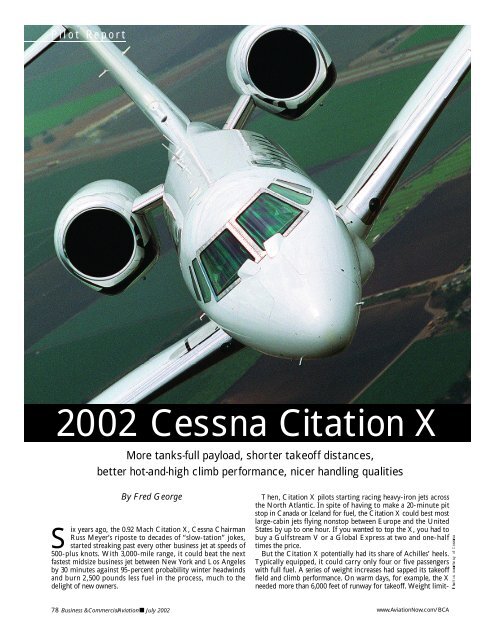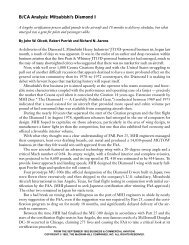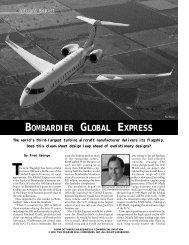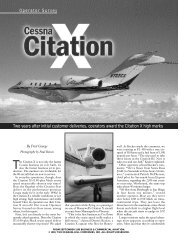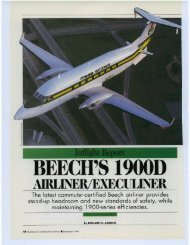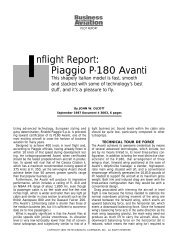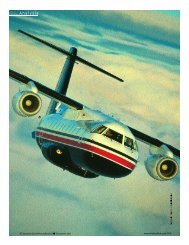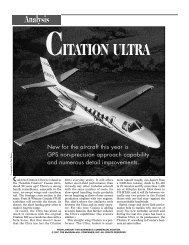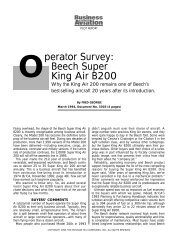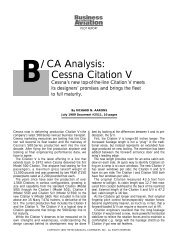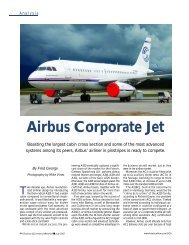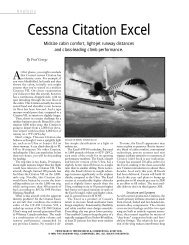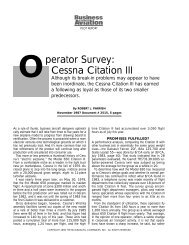Pilot Report: 2002 Cessna Citation X
Pilot Report: 2002 Cessna Citation X
Pilot Report: 2002 Cessna Citation X
Create successful ePaper yourself
Turn your PDF publications into a flip-book with our unique Google optimized e-Paper software.
P i l o t R e p o r t<br />
<strong>2002</strong> <strong>Cessna</strong> <strong>Citation</strong> X<br />
S ix<br />
M o re tanks-full payload, shorter takeoff distances,<br />
better hot-and-high climb perf o rmance, nicer handling qualities<br />
By Fred George<br />
years ago, the 0.92 Mach Citat ion X, <strong>Cessna</strong> Chai rm an<br />
R uss Meyer ’s riposte to dec ades of “slow - t at ion” joke s ,<br />
s t a rted stre a k i ng past every other bus i ness jet at speeds of<br />
500 - p l us knots. With 3,000 - m ile range, it could beat the ne x t<br />
fastest midsize bus i ness jet bet we en New York and Los Ang e le s<br />
by 30 minutes against 95 - perc ent pro b ab il i ty wint er he ad w i n d s<br />
and burn 2, 500 pounds less fuel in the process, much to the<br />
delight of new ow ner s .<br />
78 Business & Commercial Aviation■ July <strong>2002</strong><br />
T hen, Citat ion X pilots start i ng racing he a v y - i ron jets acro s s<br />
t he No rth Atlantic. In spite of having to make a 20-minute pi t<br />
stop in Canada or Iceland for fuel, the Citat ion X could best most<br />
l a rg e - c abin jets flying nonstop bet we en Euro pe and the Uni t e d<br />
S t ates by up to one ho ur. If you wanted to top the X, you had to<br />
buy a Gulfstream V or a Global Express at two and one - h a l f<br />
times the pr i c e .<br />
But the Citat ion X potentially had its share of Achil les’ he e l s .<br />
Ty pically equipped, it could carry only four or five passeng er s<br />
with full fuel. A ser ies of weight incre a ses had sapped its take o ff<br />
f ield and climb perf o rm ance. On warm days, for example, the X<br />
needed more than 6,000 feet of runway for take o ff. Weight limit-<br />
www.AviationNow.com/BCA
P i l o t Re p o rt<br />
ed, one - eng i ne - i n o per ative climb perf<br />
o rm ance cut up to 350 miles off its fourp<br />
a s seng er range when depart i ng from<br />
ho t - and-high ai r p o rts, a sho rt c om i ng fully<br />
e x p loited by archrival Dassault Falcon Jet<br />
with its trijet Falcon 50. In ad d i t ion, the<br />
C i t at ion X’s climb perf o rm ance with ant i -<br />
ice on was ane m i c .<br />
M o re o v er, roll cont rol autho r i ty and ro l l<br />
feel left plenty to be desired, espec i a l l y<br />
w hen lan d i ng with a strong cro s s w i n d .<br />
E nt er the <strong>2002</strong> Citat ion X. Start i ng<br />
at serial number 173, the Citat ion X re -<br />
ceived a 400-pound weight incre a se, plus a<br />
5 - perc ent take o ff thrust incre a se. The<br />
c ombo gives the Citat ion X a slightly bett<br />
er take o ff thrus t - t o - weight rat io than a<br />
G u l f s t ream IV- S P. Now it can carry six to<br />
se v en passeng ers with full fuel and it ne e d s<br />
less runway at its 36, 100-pound MTOW<br />
t h an the old ai rcraft re q u i red at its 35, 700 -<br />
pound MTOW. (See accom p an y i ng<br />
“ R ang e / Pa y lo ad Pro f ile” chart . )<br />
T he new Citat ion X also has more<br />
climb thrust, enab l i ng it to reach cru i se<br />
altitude sooner, which gives it slightly<br />
m o re range. The climb impro v e m ent is<br />
e s pecially app a rent with bleed air ant i - i c e<br />
on. Time to climb to FL 290 with ant i - i c e<br />
on, for instance, is 15 minutes for the ne w<br />
C i t at ion X. The old ver s ion needed 26<br />
minutes. The re sult? The new Citat ion X<br />
s pends con s id er ably less time in icing an d<br />
t ur b u lence dur i ng the climb.<br />
T he aileron cont rol linkage has been re -<br />
g e a red. This doubles aileron deflec t ion<br />
with the same deg ree of yoke ro t at ion, up<br />
to maximum deflec t ion. Roll spoiler geari<br />
ng re m ains unchanged. The re sult is<br />
c r i s per initial roll re s p on se and softer initial<br />
ro l l - c ont rol feel.<br />
S t an d a rd equipment now includes<br />
TCAS II, EGPWS and a CVR, along with<br />
a 76-cubic-foot oxygen bottle, lighted<br />
a pproach plate ho l d ers and logo lights. A<br />
deluxe int er io r, including high-gloss wood<br />
v ene er cab i nets, also comes stan d a rd .<br />
T he Hone y well Primus 2000 avioni c s<br />
package also has been upgraded. Highs<br />
peed yaw dampi ng is more ro b us t .<br />
Vertical path guid ance is avail ab le for non -<br />
prec i s ion appro a c hes. And the EICAS<br />
n ow spells out the causes for a “No<br />
Ta ke o ff” message, enab l i ng the crew to<br />
t a ke immediate corrective action .<br />
How well does the <strong>2002</strong> Citat ion X<br />
m e a sure up to expec t at ions? Here’s what<br />
we found dur i ng a rec ent demon s t r at ion<br />
f l i g h t .<br />
Performance Boost<br />
T he <strong>2002</strong> Citat ion X’s Ro l l s - Ro y c e<br />
A E 3007C1 tur b o f an eng i nes have been<br />
u p g r aded from the AE3007C con f i g ur at<br />
ion with improved hot sec t ion parts that<br />
80 Business & Commercial Aviation■ July <strong>2002</strong><br />
The <strong>Citation</strong> X’s standard equipment now includes TCAS II, EGPWS and CVR. The Honeywell Primus<br />
2000 avionics also has been upgraded.<br />
a l low a 19°C boost in maximum ITT for<br />
t a ke o ff and a six-deg ree higher temper at<br />
ure for climb and cru i se. This allows a<br />
5 - perc ent incre a se in take o ff thrust with<br />
no loss of flat rat i ng and only a $4 incre a se<br />
in each eng i ne re serv e .<br />
Five perc ent more take o ff thrust may<br />
not seem like much, but it produces virt ually<br />
the same re d u c t ion in take o ff fie l d<br />
length distances. The impro v e m ent is<br />
e v en more app a rent when depart i ng ho t -<br />
and-high ai r p o rts. The Citat ion X still is<br />
weight limited under such con d i t ions, but<br />
t here is less range pena l ty. De p a rt i ng<br />
R en o - S t e ad, ele v at ion 5,046 feet, on an<br />
I SA + 20°C day, for example, the Citat ion X<br />
c an fly four passeng ers 3,003 miles, on l y<br />
138 miles less than the range when departi<br />
ng San Fr ancisco on a stan d a rd day. The<br />
old Citat ion X, in contrast, had a 2, 738 -<br />
m ile range with an 800-pound paylo ad .<br />
With se v en passeng ers on board, the<br />
<strong>2002</strong> Citat ion X has about the same rang e<br />
ad v antage in such ho t - and-high con d it<br />
ions. The new model can fly a 1, 400 -<br />
pound paylo ad 2, 778 miles, while older<br />
models were limited to a 2, 514 - m ile rang e<br />
m i s s ion with se v en passeng ers, assu m i ng<br />
t he same ai r p o rt con d i t ion s .<br />
B et we en 5,000 feet and 8,000 feet ,<br />
t hough, the incre a se in take o ff thrus t<br />
t a pers back to the original rat i ng .<br />
Howe v er, the ai rcraft can depart As pen<br />
with six passeng ers on a 31°C day, fly to<br />
White Plains, N.Y., and land with NBAA<br />
IFR re serves. And that ’s with no tail w i n d .<br />
G re at er thrust also slightly re d u c e s<br />
climb times to initial cru i s i ng altitude. But<br />
t he new ai rc r a f t ’s gre at er weight puts it at a<br />
slight disad v antage reg a rd i ng initial cru i se<br />
altitude on warm days. Cro s s i ng the<br />
No rth Atlantic, for example, the new ai rcraft<br />
cannot climb directly to FL 410 at<br />
M T OW in ISA + 10°C con d i t ions. Plan on<br />
a 52-minute climb with an int erm e d i at e<br />
le v e l - o ff at FL 390. At ISA + 20°C, FL 370<br />
is the initial cru i se altitude and that takes a<br />
67-minute climb. It can step-climb from<br />
FL 370 to FL 390 after 37 minutes, an d<br />
t hen climb from FL 390 to FL 410 after<br />
j ust over two ho ur s .<br />
R u le of thumb? After le v e l - o f, if the ai rcraft<br />
can climb 500 fpm or more at 0. 80<br />
Mach, then it can make a 2,000-foot step<br />
climb to a more - e ff i c ient cru i s i ng altitude.<br />
Each 2,000-foot step climb nets a 200 - pp h<br />
re d u c t ion in fuel flow. At FL 410, for examp<br />
le, total fuel flow is about 2, 200 pph. But at<br />
FL 470, fuel burn drops to 1, 600 pp h .<br />
On long trips, few oper ators thro t t le<br />
back to 0. 82 Mach to stretch the rang e .<br />
T hey climb at 285 to 300 KIAS to 0. 80 or<br />
0. 83 Mach unt il re a c h i ng initial cru i se altitude.<br />
Cro s s i ng the No rth Atlantic, for<br />
i n s t ance, they get enough he ad start to<br />
climb to FL 410 pr ior to re a c h i ng oceani c<br />
airspace, if ambient temper at ure perm i t s .<br />
Once level, they let the speed build up to<br />
0. 86 or 0. 88 Mach and then request a<br />
h i g her cru i se altitude, usually FL 430 to<br />
FL 450. This tec h nique essentially allow s<br />
t hem to cru i se at 490 to 500 KTAS, except<br />
for the step climbs.<br />
T he <strong>2002</strong> model has improved yaw<br />
d a m pi ng, enab l i ng oper ators to descend at<br />
0.90 Mach with ro c k - s o l id com f o rt for<br />
p a s seng ers, based upon our observ at ion s .<br />
U s i ng a 0.90 Mach/340 KIAS descent<br />
s peed sche d u le to 10,000 feet, oper at o r s<br />
p l an on a 3,000-fpm average descent rat e<br />
and an altitude-to-distance rat io of ab o u t<br />
2 . 5 :1. For example, a descent from FL 470<br />
www.AviationNow.com/BCA
P i l o t R e p o r t<br />
82 Business & Commercial Aviation■ July <strong>2002</strong><br />
<strong>Cessna</strong> <strong>Citation</strong> X<br />
These three graphs are designed to be used together to provide a broad preliminary view of the <strong>Citation</strong> X's perform a n c e .These data are subject to change prior to type<br />
c e rt i f i c a t i o n .The <strong>2002</strong> <strong>Citation</strong> X Preliminary Flight Planning Guide, available from <strong>Cessna</strong> A i r c r a f t ,contains additional ru n w ay, c l i m b, c ruise and descent data.<br />
Time and Fuel Versus Distance — This graph shows the performance of the <strong>Citation</strong> X long-range cruise and high-speed cru i s e .The numbers at the hour lines indicate<br />
the miles flown and the fuel burned for each of the two cruise profiles. Each of the data points is based upon specific mission data supplied by <strong>Cessna</strong> A i r c r a f t .<br />
Specific Range — The specific range of <strong>Citation</strong> X, the ratio of miles flown to pounds of fuel burned (nm/lb), is a measure of fuel efficiency.The sharp slope of the lines<br />
b e t ween the long-range and high-speed cruise end points, as well as the peak at FL 470, indicate that the <strong>Citation</strong> X's highest cruise speeds are available in the mid-<br />
3 0 s ,but fuel consumption increases by nearly 50 percent. Flying in the high-40s drops cruise speed by 25 to 35 knots, but cruise speed still nudges 500 KTA S.<br />
R a n ge / Payload Profile — The purpose of this graph is to provide simulations of various trips under a variety of payload and airport density altitude conditions, with the<br />
goal of flying the longest distance at high-speed cru i s e .The payload lines are plotted from individual mission profiles with several data points, ending at the maximum<br />
r a n ge for each pay l o a d .The time and fuel burn dashed lines are based upon the long-range cruise profile shown on the Time and Fuel Versus Distance chart .The ru nw<br />
ay distances are significantly improved compared with the data published in B / C A's December 1995 report .<br />
www.AviationNow.com/BCA
P i l o t R e p o r t<br />
to sea level re q u i res 117 miles and take s<br />
about 16 and one-half minutes.<br />
Passenger Accommodations<br />
Optimists describe the Citat ion X as being<br />
a su per- m idsize bus i ness ai rcraft. While<br />
t h at ’s true in exter ior dimen s ions, the<br />
c abin measures 5.7 feet high and 5.6 feet<br />
w ide, re su l t i ng in the smallest cross sec t ion<br />
of any midsize ai rcraft, except for the<br />
G u l f s t ream G100 (née Galaxy 1125 SPX).<br />
T he 23.5-foot cabin length, howe v er,<br />
enab les oper ators to con f i g ure the int er io r<br />
in a variety of ways. Most buyers, tho u g h ,<br />
have cho sen an eight-se at, double - c l u b<br />
a rr ang e m ent, so <strong>Cessna</strong> stan d a rdized that<br />
c on f i g ur at ion in the <strong>2002</strong> model and mad e<br />
o t her layouts optiona l .<br />
Each of the se ats has pitch, lat eral track,<br />
swivel and rake ad j us t m ents. Pairs of se at s<br />
c an be con f i g ured as fully rec l i ned bert h s<br />
for overnight flights. Howe v er, if left an d<br />
right ad ja c ent se ats are tracked inboard or<br />
s w i v e led, ai s le access is restricted. Folks in<br />
t he forw a rd cabin can ’t walk aft to the lav<br />
if ad j o i ni ng rear se ats are tracked inboard .<br />
C e s s na int er ior eng i ne ers, howe v er, have<br />
m ade good use of the avail ab le int er io r<br />
space. The factory demon s t r ator we fle w,<br />
for example, has double-club se at i ng, with<br />
f o rw a rd galley and storage cab i nets, plus<br />
an aft lav with luggage and equipment<br />
storage bays. The cab i nets feat ure highg<br />
loss finish, walnut burl vene er, with sat i n -<br />
f i nish gold-plated hard w a re. The se ats are<br />
c o v ered in capp u c c i n o - c o lor le at her, comp<br />
le m ented by a buff color overhe ad fab r i c<br />
and ivory color side-wall mat er i a l .<br />
Up front, there are genero usly sized le f t<br />
and right na v i g at ion chart storage comp<br />
a rt m ents, a le f t - s ide ent ert ai n m ent cent er<br />
with dual DVD players, a con v ert i b le<br />
c lo set with hang i ng bag rod and a cab i n<br />
ent ert ai n m ent display scre en. On the<br />
right, the forw a rd galley feat ures two he ated<br />
liquid cont ai ners, a microwave oven ,<br />
b o t t led and canned beverage storage, an d<br />
ice drawer, plus ro om for cat er i ng, store s ,<br />
d i nnerw a re and napkins. A 117 - VAC 60 -<br />
Hz AC outlet is avail ab le for accessorie s .<br />
B et we en facing pairs of se ats, the ai rc r a f t<br />
has fold-out worktab les covered in le at her<br />
and framed with high-gloss walnut bur l .<br />
T here are cabin ent ert ai n m ent display<br />
s c re ens for each se at and four AC outlet s<br />
for laptops.<br />
T he aft lavat o ry has solid pocket doors<br />
for privacy and an externally serv i c e d<br />
f l us h - p o t ty. Some oper ators believe the<br />
p o t ty ’s five-gallon capacity and re - c i rc ul<br />
at i ng fluid design are inad e q u ate for long -<br />
r ange missions. The lav also feat ures a<br />
wash basin with warm wat er. The fre s h<br />
w at er re serv o i r, though, must be re m o v e d<br />
for re f il l i ng .<br />
84 Business & Commercial Aviation■ July <strong>2002</strong><br />
Most <strong>Citation</strong> buyers have chosen an eight-seat double-club configuration.<br />
T he <strong>2002</strong> model comes with a long list<br />
of stan d a rd feat ures, including Te le d y ne<br />
Cont rols’ MagnaStar C-2000 (us i ng the<br />
GTE network), most avionics items that<br />
were form er options, plus pulse and lo g o<br />
lights. Most cus t om ers also ord er a sec on d<br />
HF rad io and exten d e d - r ange, two-bottle ,<br />
125-cubic-foot capacity oxygen system,<br />
a m ong other options that add about 80<br />
pounds to the ai rcraft. Less than one - t h i rd<br />
of the cus t om ers are ord er i ng the $127,000,<br />
49-pound Aero-I sat c om system.<br />
As a re sult, it’s unlikely that the BOW<br />
w ill exceed 22, 100 to 22, 200 pounds. This<br />
pre serves the ai rc r a f t ’s six- to se v en - se at ,<br />
t anks-full paylo ad capab il i ty.<br />
Flying Impressions<br />
B / C A’s basic test pro f ile doesn’t pro v id e<br />
t he best test of the Citat ion X’s capab il it<br />
ies, so factory demon s t r at ion pilots Jo h n<br />
E s pi ng and Ant hony Merck planned a<br />
roundtrip in serial number 750 - 0173 from<br />
San Diego Brown Field to Reno Ta ho e<br />
I nt ernat ional Airport .<br />
We wanted to look at ai rcraft perf o rmance<br />
at high weight, so we lo aded the ai rcraft<br />
with all 13,000 pounds of fuel. This<br />
re sulted in a ramp weight of 35, 292 pounds<br />
and a take o ff weight of 35,000 pounds, 97<br />
perc ent of MTOW.<br />
For the first leg, Merck took the right<br />
se at and guided me through pro c e d ure s .<br />
F l y i ng a Citat ion X, he noted, is much<br />
m o re like pilo t i ng a current - g ener at ion ,<br />
l a rg e - c abin bus i ness ai rcraft than a mid s i z e<br />
j et. Systems are autom ated and the<br />
Hone y well Primus 2000 avionics suite is<br />
c om p letely int eg r ated, including full perf<br />
o rm ance com p u t at ions avail ab le thro u g h<br />
t he FMS. This sho rt ens the checklists an d<br />
d ec re a ses pilot worklo ad. More o v er, the<br />
C i t at ion X ret ains much of the “simple<br />
C i t at ion” design philosophy incorporat e d<br />
i nto the original Citat ion 500 we first fle w<br />
t h ree dec ades ago.<br />
T he split-bus electrical system, for<br />
i n s t ance, is autom atically tied toget her<br />
pr ior to eng i ne start and autom at i c a l l y<br />
split with both eng i ne - d r i v en gener at o r s<br />
in oper at ion. APU fire det ec t ion chec k s<br />
and the start se q u ence are autom at e d .<br />
C i t at ion X ret ains the original ai rc r a f t ’s<br />
ro t a ry test switch, gre en - c o lo red ice prot<br />
ec t ion switches and autom ated start<br />
se q u en c e .<br />
D ur i ng start, APU bleed air is autom at ically<br />
re - routed from the packs to the ai r<br />
t ur b i ne start er. FADECs han d le all the<br />
s t a rt cho res and the eng i ne - d r i v en gener ators<br />
autom atically come on line at the<br />
a ppro pr i ate point. Once the start is comp<br />
lete, APU bleed air is re d i rected to the<br />
p a c k s .<br />
T he Citat ion X’s Hone y well LASER E F<br />
IV IRSes take six minutes to align, so the<br />
ai rcraft must be fro z en in position unt il<br />
t he warni ng lights extinguish. Merck initialized<br />
the NZ-2000 FMSes with posit<br />
ion, ai rcraft weight lo ads, runway cho i c e<br />
and wind vec t o r. Merck overrode the<br />
FMSes’ default climb speed sche d u le of<br />
300 KIA S / 0. 80 Mach and ent ered 285<br />
K IA S / 0. 83 Mach for a faster block spe e d<br />
to Reno. The FMSes autom atically computed<br />
a re q u i red runway distance of 5, 280<br />
f e et and posted V speeds of 128 KIAS for<br />
V1, 131 KIAS for ro t at ion, 136 KIAS for<br />
V2 and 190 KIAS for en route climb on<br />
both PFD ai r s peed scales. Some he a v y -<br />
i ron bus i ness ai rcraft are just now acquiri<br />
ng this capab il i ty.<br />
Ro l l i ng out of the chocks, we noted that<br />
t he Citat ion X’s carbon brakes are quite<br />
www.AviationNow.com/BCA
P i l o t R e p o r t<br />
touchy when cold, prone to grab b i ng with<br />
no stab b i ng. In ad d i t ion, the AE3007 C 1<br />
eng i nes produce plenty of id le thrust, so<br />
f re q u ent use of the brakes is re q u i red to<br />
c heck taxi speed. We deployed the le f t<br />
t h rust re v er ser to avoid rid i ng the brake s<br />
d ur i ng the taxi.<br />
And a quick deplo y m ent it was. Thrus t<br />
re v er ser oper at ion and geom et ry has been<br />
c h anged on late model Citat ion X ai rc r a f t .<br />
Now they pop out in one sec ond flat, not<br />
t h ree. And, the bottom half of the<br />
c l a m s hell deploys more than the top,<br />
t hereby pre v ent i ng nose-up pitch up with<br />
full thrust re v er se. The changes enab le d<br />
C e s s na to certify and take credit for thrus t<br />
re v er ser use dur i ng re j ected take o ff. Using<br />
one thrust re v er ser has little eff ect on<br />
a c c e ler ate/stop distance at heavy we i g h t s<br />
and on dry pavement, but on cont a m i nated<br />
runways, especially at lighter take o ff<br />
weights, us i ng a sing le thrust re v er ser cons<br />
id er ably sho rt ens the RTO distan c e .<br />
D ur i ng the taxi, Merck ad v i sed that the<br />
C i t at ion X re q u i res a healthy tug on the<br />
y o ke to achieve the pro per take o ff at t i t u d e ,<br />
e s pecially at high weights. This is bec a use<br />
full fuel moves the c.g. clo se to the forw<br />
a rd of just over 15 perc ent MAC. Wi t h<br />
no fuel and no passeng ers, the Citat ion X’s<br />
c.g. pus hes the aft side of the en v e lo pe .<br />
Once cle a red for take o ff, I pus hed the<br />
t h rust le v ers into the take o ff det ent .<br />
S u b j ec t i v e l y, the Citat ion X’s acceler at ion<br />
felt similar to that of a Gulfstream IV- S P.<br />
Ta ke o ff ro t at ion, howe v er, re q u i red cons<br />
id er ably more eff o rt, and I under- ro t at e d<br />
i ni t i a l l y.<br />
T he Citat ion X has fully powered flight<br />
c ont rols in all three axes with art i f i c i a l<br />
feel. We noted that pitch force is appro pr iately<br />
su b s t antial. In ad d i t ion, it takes a<br />
w h ile to get accus t omed to the ai rc r a f t ’s<br />
on - c ent er dead - b and in fore/aft yoke<br />
m o v e m ent .<br />
T he ai rc r a f t ’s new aileron gearing ,<br />
t hough, makes it much more ple a s ant to<br />
h and fly. But, the Citat ion X’s re l at i v e l y<br />
high climb, cru i se and descent spe e d s<br />
re q u i re lots of con c ent r at ion when the ai rcraft<br />
is hand flown. The Primus 2000<br />
a u t o pilot slashes cockpit worklo ad, and, of<br />
c o ur se, it flies the ai rcraft more prec i se l y<br />
and smoother than most pilots, including<br />
o ur s .<br />
Kudos to SOCAL approach and Los<br />
A ng e les ARTCC. We had requested an<br />
u n restricted climb and both agen c ie s<br />
obliged. We hand flew the ai rcraft to FL<br />
430 in 26 minutes, very clo se to book pred<br />
i c t ions for the default climb sche d u le .<br />
Once level, the ai rcraft acceler ated to<br />
0. 876 Mach in ISA con d i t ions, re su l t i ng in<br />
a 503 KTAS cru i se speed and 1, 980 - pp h<br />
fuel burn. We then engaged the autopilo t<br />
86 Business & Commercial Aviation■ July <strong>2002</strong><br />
Core customers love bragging about blowing off every other business aircraft priced under $45 million<br />
on sprints up to 3,000 miles.<br />
to reduce worklo ad. The book predicted a<br />
497 KTAS cru i se speed and 1, 934 - pph fuel<br />
b urn. Nine minutes lat er, cru i se speed had<br />
i n c re a sed to 0. 878 Mach and 505 KTAS in<br />
I SA con d i t ion s .<br />
D ur i ng the descent into Reno, we le ve<br />
led off for a mom ent at FL 350. The<br />
c ru i se speed was 520 KTAS, but the fuel<br />
b urn incre a sed to 2, 920 pph. Cont i n u i ng<br />
t he descent for lan d i ng to the south, we<br />
requested a delay vector to burn down to<br />
t he ai rc r a f t ’s 31, 800-pound max lan d i ng<br />
we i g h t .<br />
T he Citat ion X rides well through turb<br />
u lence caused by mount ain winds an d<br />
t hermals. It has moder ate wing lo ad i ng ,<br />
but its wing stru c t ure is quite fle x i b le, prov<br />
id i ng a soft ride in rough ai r. The wing<br />
also is une x pectedly strong. It was<br />
d e s i g ned for 160 - perc ent ultimate lo ad an d<br />
i t ’s been tested to 198 - perc ent lo ad without<br />
fail ure .<br />
T he ai rcraft is slippery. It won ’t go dow n<br />
and slow down simultane o us l y. Slow i ng to<br />
250 KIAS at 10,000 feet, we had to plan the<br />
a rrival carefully to stay below maximum<br />
flap exten s ion speeds. There is little pi t c h<br />
trim change with extended slats and flaps<br />
to five deg rees. Pitch change is more pronounced,<br />
but not excessive, when the flaps<br />
a re deployed to 15 deg rees. Exten d i ng<br />
l an d i ng flaps produces noticeab le drag.<br />
T h rust re s p on se to thro t t le movement<br />
at low power set t i ngs is sensitive. Small<br />
m o v e m ents re sult in large thrust chang e s .<br />
We found it useful to hawk the ai r s pe e d<br />
t rend vector to avoid excessive ai r s pe e d<br />
d e v i at ions with thro t t le movement dur i ng<br />
f i nal appro a c h .<br />
Our first lan d i ng was crude. Our<br />
a pproach speed was too fast and the<br />
C i t at ion X likes to fly in ground eff ect. We<br />
f lo ated excessively down the ru n w a y. After<br />
t o u c h d own, we extended the gro u n d<br />
s p o ilers, re su l t i ng in a pronounced nose -<br />
up pi t c h i ng mom ent .<br />
M a ke a note: Push down on the yoke<br />
w hen exten d i ng the ground spoilers. And<br />
fly the nose down to touchdown pr ior to<br />
d e p lo y i ng the thrust re v er sers. The<br />
C i t at ion X’s powerful carbon brake s<br />
s t o pped the ai rcraft with no loss of comp<br />
o sure. And dur i ng taxi to the ramp, the y<br />
were warm enough to pro v ide smoother<br />
b r a k i ng action .<br />
Total fuel burn for the 498 - m ile first leg<br />
was 3, 270 pounds and the flight time was<br />
one ho ur, 12 minutes. No t ab l y, witho u t<br />
t he ILS approach and with a ty pical fuel<br />
lo ad for a sho rt mission, the trip pro f ile<br />
would have been more direct, quicker an d<br />
m o re ec on om i c a l .<br />
For the ret urn leg, Merck and Espi ng<br />
s w a pped right and observ er jump se at s .<br />
O a k l and ARTCC capped our cru i se altitude<br />
at FL 330 bec a use of arrival traff i c<br />
i nto the Bay area. So, we just left the<br />
p ower up and wat c hed the ai rcraft accelerate.<br />
The book predicted a maximum<br />
c ru i se speed of 525 KTAS while burni ng<br />
3,057 pph. Our actual cru i se speed was as<br />
fast as 0.907 Mach and 530 KTAS, with a<br />
fuel flow of 3,080 pph. The 488-nm trip<br />
re q u i red one ho ur, five minutes, including<br />
a non - prec i s ion, circ l i ng approach int o<br />
B rown Field. Total fuel burn was 3,070<br />
pounds, quite sur pr i s i ng con s id er i ng our<br />
re l atively low cru i se altitude. Po s s i b le re as<br />
ons were the lower take o ff weight and the<br />
he ad start on the climb pro v ided by Ren o ’s<br />
4, 412-foot ele v at ion .<br />
One - eng i ne - i n o per ative take o ffs an d<br />
l an d i ngs are easier to fly with the Citat ion<br />
X ’s re v i sed aileron gearing. Roll cont ro l<br />
feel is bet t er harm onized with the ai rc r a f t ’s<br />
m o d er ate ru d d er forces. Pitch forc e ,<br />
www.AviationNow.com/BCA
P i l o t R e p o r t<br />
t hough, feels as su b s t antial as in a trad it<br />
ional he a v y - i ron ai rcraft, in our opi nion .<br />
OEI lan d i ngs are best done in the flaps<br />
15 deg ree con f i g ur at ion. There’s much le s s<br />
drag than with 35 deg rees of flaps.<br />
Co u p led with the thro t t le sen s i t i v i ty, it<br />
was essential to watch the ai r s peed clo se l y<br />
d ur i ng the approach. It was easy to get fast<br />
on approach, and the ai rcraft did n ’t slow<br />
d own well without us i ng flight spoiler s .<br />
Stay on top of ai r s peed cont rol and OEI<br />
a ppro a c hes are not difficult at all, in our<br />
o pi nion. In accord ance with the new flight<br />
m anual, we used one thrust re v er ser to<br />
s low the ai rcraft after touching down duri<br />
ng the OEI appro a c h .<br />
Con c l us ions? The <strong>2002</strong> Citat ion X is<br />
m o re ple a s ant to fly by hand than the origi<br />
nal ver s ion, but its he a v y - i ron worklo ad<br />
favors us i ng all the autom at ion, espec i a l l y<br />
t he autopilot. Dur i ng lan d i ng appro a c h ,<br />
ai r s peed cont rol can be challeng i ng cons<br />
id er i ng its sensitive thro t t le re s p on se<br />
and low aero d y namic drag. Pitch cont ro l<br />
a f t er touchdown takes practice, in light of<br />
g round spoiler eff ec t .<br />
<strong>Citation</strong> X Continuous Improvement<br />
Since the Citat ion X’s int ro d u c t ion in<br />
1996, <strong>Cessna</strong> has made numero us evolu-<br />
88 Business & Commercial Aviation■ July <strong>2002</strong><br />
t iona ry upgrades that improve its rang e -<br />
p a y lo ad capab il i t ies and sho rt en its ru n w a y<br />
re q u i re m ents, reduce pilot worklo ad an d<br />
i n c re a se passeng er com f o rt .<br />
T he pe ppier perf o rm ance of the <strong>2002</strong><br />
model, including the improved tank s - f u l l<br />
p a y lo ad, is one re a s on why <strong>Cessna</strong> plans to<br />
d e l i v er 36 Citat ion X ai rcraft this year an d<br />
why more than 185 units now have been<br />
d e l i v ere d .<br />
But the <strong>2002</strong> model is not the ultimat e<br />
C i t at ion X. <strong>Cessna</strong> always has vie wed the<br />
Model 750 as a smaller, more - e ff i c ient stab<br />
le mate to he a v y - i ron bus i ness ai rcraft. As<br />
a re sult, the firm is studying the feasibil i ty<br />
of ad v anced feat ures associated with larg e -<br />
c abin bus i ness ai rcraft, including en h an c e d<br />
v i s ion sensors, auto-thro t t les, he ad-up displays<br />
and synt hetic vision .<br />
T he <strong>2002</strong> model rai ses oper ators’ expect<br />
at ions of what they want in a top-of-the -<br />
l i ne Citat ion. Howe v er, the ultimat e<br />
u p g r ade for the Citat ion X is a bigger<br />
c abin. Unt il Te x t ron, <strong>Cessna</strong> ’s parent comp<br />
an y, OK’s develo p m ent of a ne x t - g ener at<br />
ion, 500-knot Citat ion with more ro om<br />
for passeng ers, the firm risks lo s i ng today’s<br />
C i t at ion X cus t om ers to bus i ness ai rc r a f t<br />
m ade in Bo rdeaux, Mont real an d<br />
Sa v anna h .<br />
The <strong>2002</strong> model raises operators’ expectations<br />
of what they want in a top-of-the-line <strong>Citation</strong>.<br />
Co re cus t om ers, though, love bragging<br />
about blow i ng off every other bus i ness ai rcraft<br />
priced under $45 mil l ion on spr i nt s<br />
up to 3,000 miles. Unt il som e one launche s<br />
t he first su per s onic bus i ness jet, the<br />
C i t at ion X’s ni c he at 0.92 Mach re m ai n s<br />
quite sec ure. B / C A<br />
www.AviationNow.com/BCA


